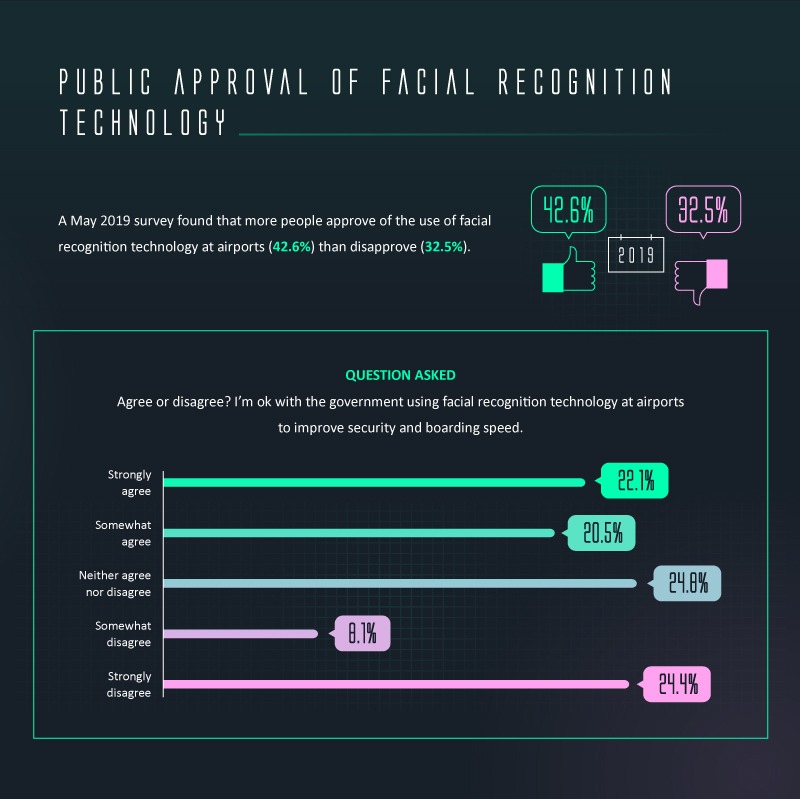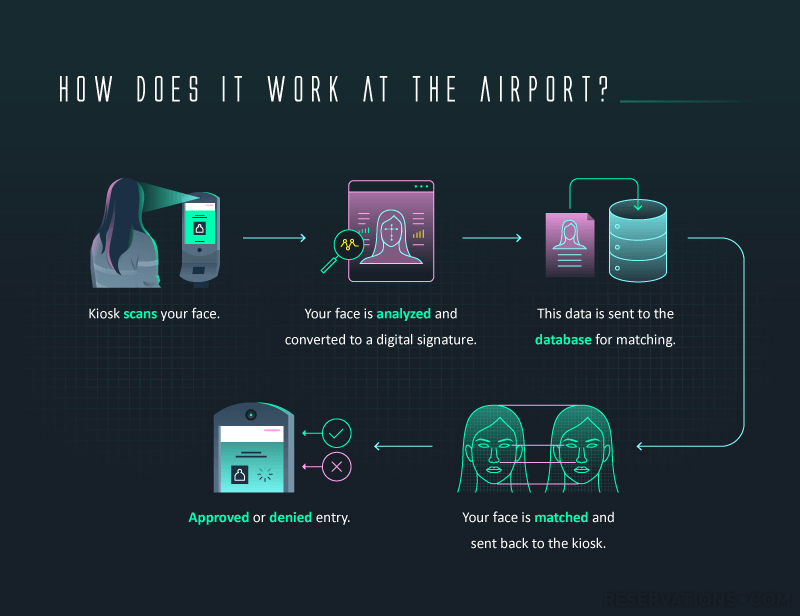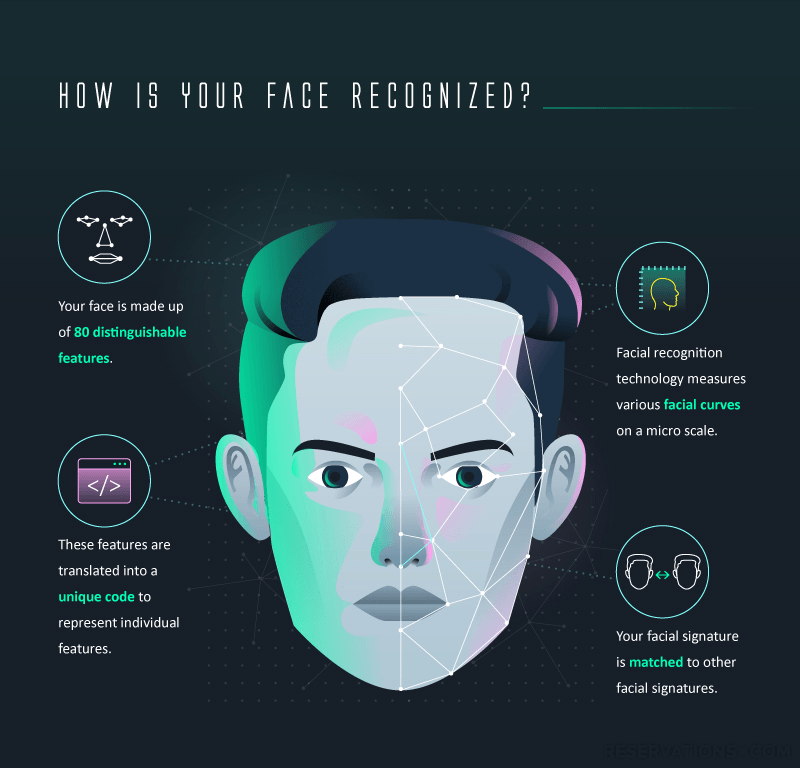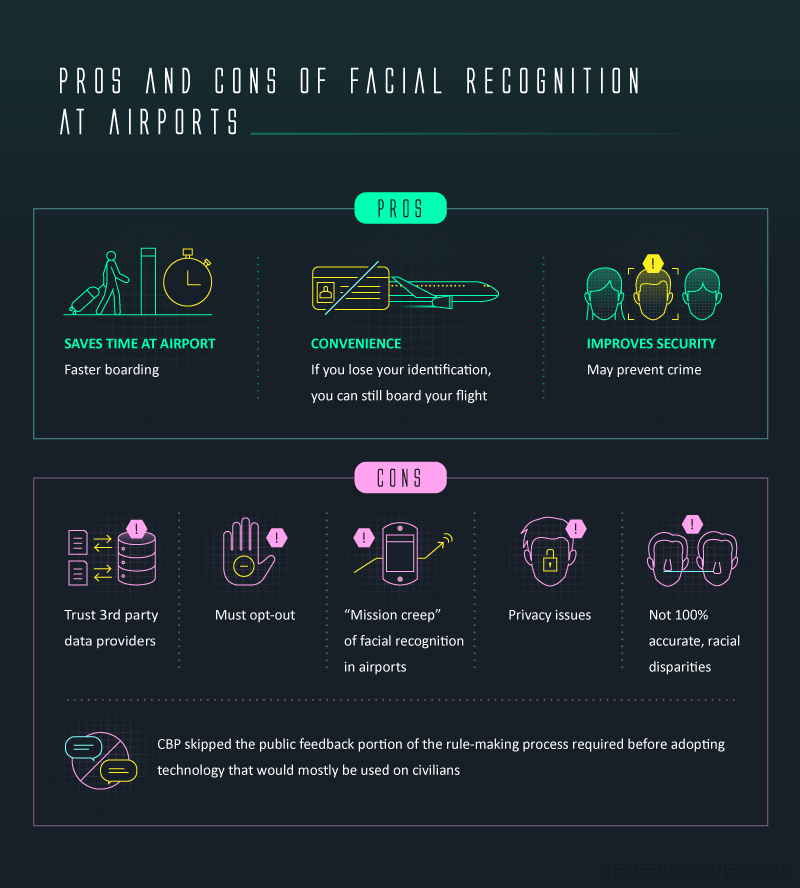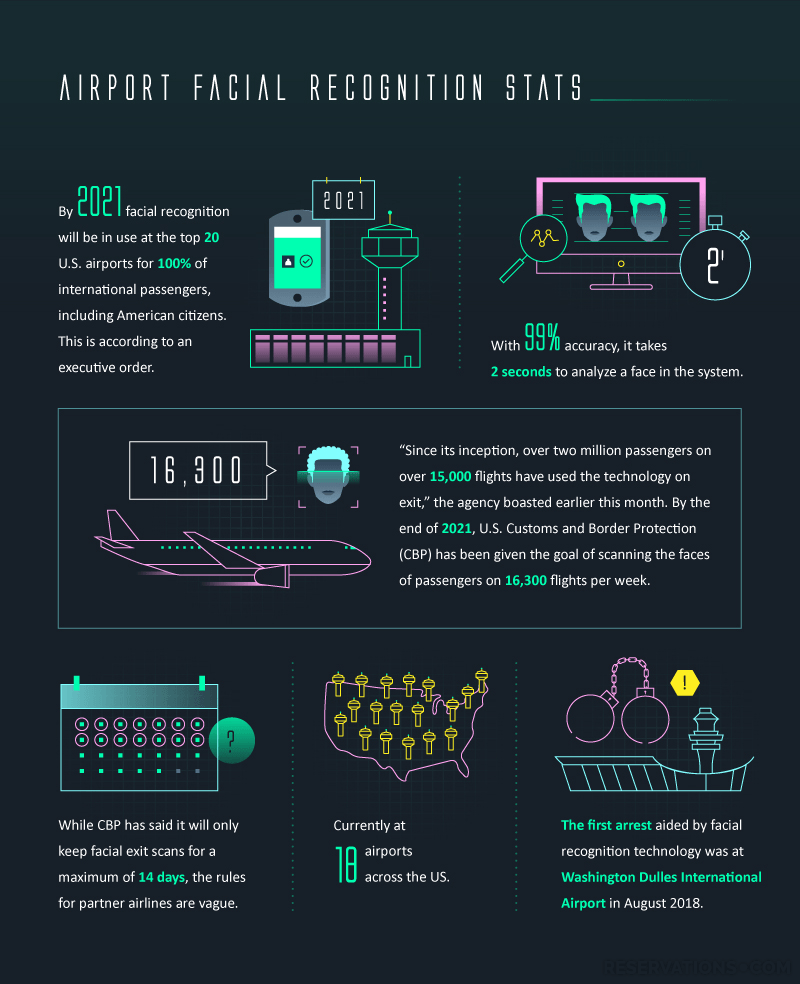Only one in three Americans (32.5%) disagree with the government using facial recognition technology at airports to improve security and boarding speed, according to a new survey from travel search engine Reservations.com.
Conversely, 42.6% of those surveyed approve of the use of facial recognition technology to improve security and boarding speed.
One-quarter of Americans (24.8%) neither agree nor disagree.
Survey Results
Agree or disagree? I’m ok with the government using facial recognition technology at airports to improve security and boarding speed.
- Strongly agree: 22.12%
- Somewhat agree: 20.49%
- Neither agree nor disagree: 24.83%
- Somewhat disagree: 8.11%
- Strongly disagree: 24.45%
How Facial Recognition Technology Works at the Airport
Facial recognition technology at airports works in conjunction with law enforcement and government databases to recognize the passenger. In the United States, the U.S. Customs and Border Protection (CBP) maintains the database. The matching is instantaneous and is 99% accurate.
According to the The Wall Street Journal, “U.S. Customs and Border Protection is using facial recognition to fulfill a congressional mandate calling for a biometric entry and exit system for international visitors”. This comes from a congressional mandate on biometric entry and exit for international travel. The CBP was given responsibility for carrying out this mandate and trialing the technology at airports across the Untied States.
How is your Face Recognized?
The facial recognition system uses approximately 80 distinct markers to recognize your individual face. This technology analyzes facial curves on a micro scale and then translates those characteristics into a unique signature which is then matched to the database of facial signatures. In the United States, the CBP matches against passport photos for both international visitors and U.S. citizens.
The Facial Recognition Debate
Citizens are mixed on their opinions of facial recognition technology, as shown in our survey. There are many pros and cons for governments to work out in the coming years. With a plan to roll out this technology at 97% of airports by 2023, this will quickly become a new normal.
The best arguments for facial recognition technology point to the convenience and improved security. Faster boarding and shorter security lines is something we can all get behind, but the tradeoffs of privacy have to be considered. Security improvements are welcomed, especially in the anxiety of post-9/11 airport screening procedures, but there are problems with identifying minority groups. Stats show up to 35% errors for darker skinned women, compared to 1% errors for white males.
Trusting governments and 3rd party data providers for managing and matching facial signatures is also a concern. Hacking and data breaches are a real possibility. Citizens can opt-out but the addition steps to do so mean that most won’t.
Facial Recognition Technology Stats
- By 2021, facial recognition will be in use at the top 20 U.S. airports for 100% of international passengers, including American citizens. This is according to an executive order.
- With 99% accuracy, it takes 2 seconds to analyze a face in the system.
- While CBP has said it will only keep facial exit scans for a maximum of 14 days, the rules for partner airlines vague.
- “Since its inception, over two million passengers on over 15,000 flights have used the technology on exit,” the agency boasted earlier this month. By the end of 2021, CBP has been given the goal of scanning the faces of passengers on 16,300 flights per week.
- Currently at 18 airports across the US
- The first arrest aided by facial recognition technology was at Washington Dulles International Airport in August 2018.
- A 2018 test by the ACLU found the technology incorrectly matched 28 members of Congress and identified them as people who had committed crimes
Additional Survey Findings
Table 1 – Results by Gender
Table 2 – Results by Age
Survey Methodology
This online survey polled 1,001 adult internet users in the United States from May 21 to 24, 2019 via the Google Surveys platform. Responses were weighted using gender, age, and region to match the demographics of the national internet population as estimated by the U.S. Census Bureau’s Current Population Survey.
Google Surveys statement: “We validate results against outside data, such as government-issued statistics, and results are as accurate or more accurate than other online platforms. Several analyses have found Google Surveys to be a useful survey tool. Read the whitepaper to learn more or see the analysis done by the Pew Research Center.”
Related Survey Findings
A December 2018 survey by Center for Data Innovation found the following:
Agree or disagree? The government should strictly limit the use of facial recognition technology even if it means airports can’t use it to speed up security lines.
- Strongly agree: 9.6%
- Somewhat agree: 10.3%
- Neither agree nor disagree: 25.7%
- Somewhat disagree: 20.5%
- Strongly disagree: 33.8%
An October 2018 survey by Brookings reported as following:
How favorable are you to using facial recognition software at airports to establish your identity?
- 31% very unfavorable
- 13% somewhat unfavorable
- 13% somewhat favorable
- 18% very favorable
- 25% don’t know or no answer
Sources
- https://www.cbp.gov/travel/biometrics
- https://deloitte.wsj.com/cio/2018/06/27/facial-recognition-changing-the-face-of-travel/
- https://www.nytimes.com/interactive/2019/04/16/opinion/facial-recognition-new-york-city.html
- https://gizmodo.com/what-your-airline-wont-tell-you-about-those-creepy-airp-1834218228
- https://www.forbes.com/sites/kateoflahertyuk/2019/03/11/facial-recognition-to-be-deployed-at-top-20-us-airports-should-you-be-concerned/#5325d1587d48
- https://www.cbsnews.com/news/delta-americas-first-biometric-facial-recognition-airport-terminal/
- https://www.travelpulse.com/news/airlines/us-government-to-roll-out-facial-recognition-software-in-most-airports-in-four-years.html
- https://www.fastcompany.com/90318183/20-major-airports-may-mandate-face-recognition-for-international-travelers-by-2021
- https://www.newsweek.com/facial-recognition-technology-what-are-your-rights-can-you-opt-out-1360477
- https://www.buzzfeednews.com/article/daveyalba/these-documents-reveal-the-governments-detailed-plan-for
- https://www.aarp.org/travel/travel-tips/transportation/info-2018/facial-recognition-at-airports.html
- https://sea.mashable.com/tech/3231/singapore-is-introducing-facial-recognition-at-tuas-checkpoint-but-there-is-one-major-drawback
- https://www.datainnovation.org/2019/01/survey-few-americans-want-government-to-limit-use-of-facial-recognition-technology-particularly-for-public-safety-or-airport-screening/
- https://www.brookings.edu/blog/techtank/2018/10/08/brookings-survey-finds-50-percent-of-people-are-unfavorable-to-facial-recognition-software-in-retail-stores-to-prevent-theft/
- https://www.reservations.com/blog/resources/facial-recognition-airports-survey/

